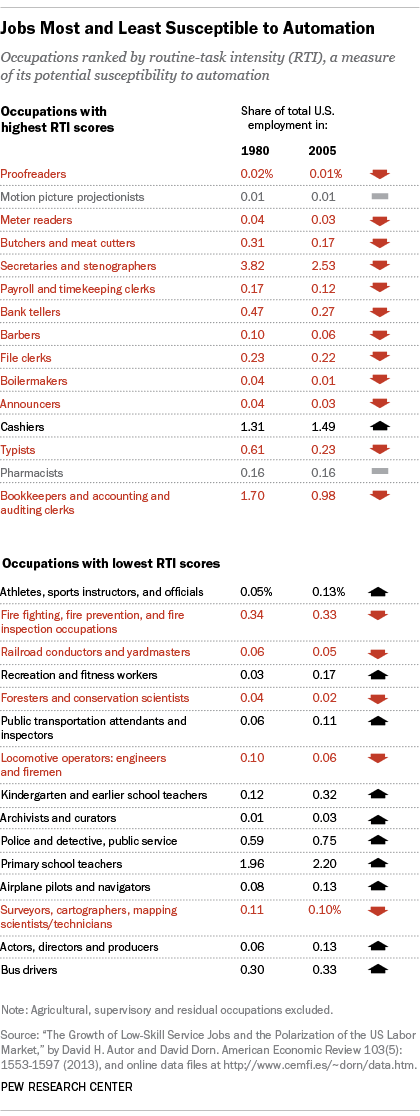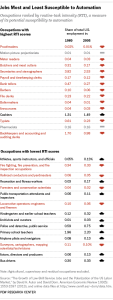For decades, labor economists have sought to quantify and predict the the impact of computer technology on both current and future employment, a subject that a new Pew Research Center report probed with a survey of nearly 1,900 experts. Computers had typically been thought of as best suited for jobs that involve routine, repetitive tasks that can easily be reduced to lines of code. But with computer-controlled devices and systems already capable of doing far more than projected even a few years ago, many experts now see more complex jobs coming into play.
The first approach is perhaps summed up by MIT economist David Autor and David Dorn, an economist at Spain’s CEMFI institute, who’ve done much of the spade work in this line of research. They wrote in a 2013 paper: “The adoption of computers substitutes for low-skill workers performing routine tasks — such as bookkeeping, clerical work, and repetitive production and monitoring activities — which are readily computerized because they follow precise, well-defined procedures.”

Consequently, Autor and Dorn say, computerization has been a major contributor to the “hollowing-out” of middle-skilled, middle-wage jobs and a corresponding rise in employment at both the high and low ends of the skills spectrum. To quantify this, the researchers developed an index of “routine task intensity,” or RTI. The higher an occupation’s RTI, the more it’s characterized by routine tasks with relatively little manual labor or abstract reasoning involved. Dorn, in a separate paper, said RTI could “be interpreted as an occupation’s potential susceptibility to displacement by automation.”
A look at the highest- and lowest-ranking nonfarm occupations by RTI seems to bear that out. Of the 15 occupations with the highest RTI scores, only one (cashiers) accounted for a higher share of U.S. employment in 2005 than it did in 1980, while 10 of the 15 lowest-RTI occupations grew as a share of total employment over that timespan.
[a]
Last year, two Oxford researchers proposed a new way of estimating how vulnerable different occupations are to future technological advances. The researchers, Carl Benedikt Frey and Michael Osborne, focused on the extent to which occupations involve three types of tasks — perception and manipulation, creative intelligence and social intelligence — that, they argue, are least likely to be fully and successfully automated within the next few decades. The more a job involves such tasks, the less susceptible it is to computerization.

Frey and Osborne analyzed 702 occupations this way, sorting them into high, medium and low risk of computerization. They concluded that 47% of total U.S. employment is in the high risk category, including most workers in transportation and logistics occupations, office and administrative support occupations, and production workers. Among the jobs at the highest risk for computerization: telemarketers, title examiners, insurance underwriters, watch repairers and tax preparers.
Much of the near-term risk of computerization, Frey and Osborne conclude, will be borne by low-skill, low-wage workers — a reversal of the “hollowing out” phenomenon that has characterized the computing age up to now. “As technology races ahead,” they write, “low-skill workers will reallocate to tasks that are non-susceptible to computerization — i.e., tasks requiring creative and social intelligence. For workers to win the race, however, they will have to acquire creative and social skills.”

